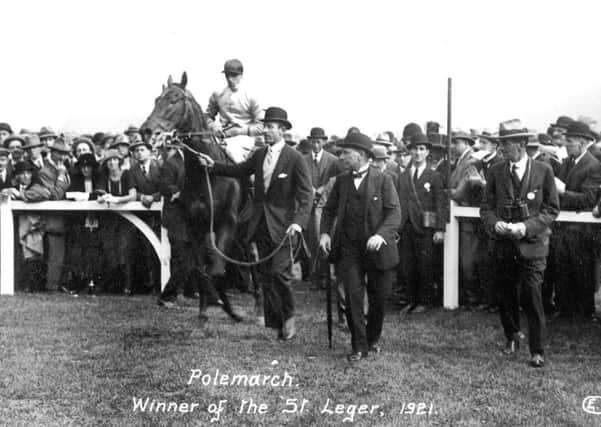Nostalgia on Tuesday: Hooked on classic


Horse racing was in favour at Doncaster in the 16th century. According to JS Fletcher in The History of the St Leger Stakes 1776-1901 (1902), there was a racecourse on the Town Moor at the very beginning of the 17th century. This is proved by an order made by Doncaster Corporation dated May 2, 1600.
During the 18th century there were a good many alterations to the race times and conditions. John Orton, in his Turf Annals of York and Doncaster (York, 1844), first mentions race meetings at Doncaster in 1728, when plates of 20 and 40 guineas each were run for on July 22 and 23. By the middle of the century, September appears to have been fixed upon as the most agreeable month of the year for celebrating what has since become regarded as an annual event of great importance.
Advertisement
Hide AdAdvertisement
Hide AdThere were five days’ racing at the September meetings of 1757 and 1758 and four in the following year. After that, the races were sometimes held on three, sometimes on four days. There was a strong local element in the first race meetings – they were the saturnalia of the surrounding district rather than the whole country. In a race-list of the meeting of 1756 there is abundant evidence the local landed gentry were the chief supporters of the event. Among the subscribers and names were the Marquis of Granby, the Marquis of Rockingham, the Earl of Scarborough, Lord Byron and Sir George Saville.
A sweepstake of 25 guineas was held over two miles on Cantley Common, two miles east of the current Doncaster racecourse, on September 24, 1776. The event was organised by Charles Watson-Wentworth, 2nd Marquess of Rockingham (a prominent politician and former Prime Minister) and was the idea of Lieutenant Colonel Anthony St Leger (a former MP). On the day, the winning horse (from a field of five) was owned by Rockingham, with a horse owned by St Leger following in second.
The event didn’t receive its name until a meeting held between the 1777 and 1778 meets. When it was suggested that the race should be called the Rockingham Stakes, the Marquess is said to have replied: “No, it was my friend St Leger who suggested the thing to me – call it after him.” In 1779, the race moved from Cantley to a new course on the Town Moor, where it remains to this day.
John Singleton rode Alabaculia, the first winner of the St Leger, for the 2nd Marquess of Rockingham, in 1776. Two other jockeys who made their mark on the race are Frederick James Archer, born January 11, 1857 and Lester Piggott, born November 5, 1935. Archer won a total of 21 classic races, the St Leger Stakes in 1877 on Silvio; 1878, Jannette; 1881, Iroquois; 1882, Dutch Oven; 1885, Melton; 1886, Ormonde. Because of his height (5ft 10in) he had to diet far more than other jockeys. This had an effect on his health, and after suffering from depression following the death of his wife, Fred committed suicide by shooting himself in November 1886.
Advertisement
Hide AdAdvertisement
Hide AdPiggott is famously tall for a jockey (5ft 8 in), hence his nickname of “The Long Fellow”. He is considered one of the greatest flat jockeys, with 4,493 career wins, including eight St Leger victories: 1960, St Paddy; 1961, Aurelius; 1967, Ribocco; 1968, Ribero; 1970, Nijinsky; 1971, Athens Wood; 1972, Boucher; 1984, Commanche Run.
During the 19th century Doncaster was almost besieged and occupied for days before and after the September meeting, and there was great variety and colour in the High Street and the Market Place. Folk of high and low standing came from far and near, driving in their stagecoaches or tramping humbly on foot to take up their residence in the town until the last winner of the meeting had caught the judge’s eye, and often for some days later.
Inns and houses were filled to overflowing, and all manner of sports and pastimes helped to amuse the anxious seekers of pleasure and excitement. There were plays at the local theatre, and assemblies and concerts in other public places. There were cock pits everywhere and those who admired the noble art could see as much boxing as they cared for.
Members of the royal family have visited Doncaster September Races on a number of occasions. King Edward VII frequently attended meetings. The Doncaster Gazette of September 14, 1909 recorded: “His Majesty was not long in appearing on the balcony and he received the customary hearty greeting from the busy crowd of sportsmen in Tattersall’s ring, just below. He was looking the picture of health, bronzed and dressed in a black frock coat and a silk hat, and wore a tie of his racing colours and a tiny orchid in his button hole. The King spent the greater part of the afternoon on the balcony, watching the sport through his field glasses, and chatting with his friends, and did not leave until the runners went out for the last race. Unfortunately, the crowd did not have the privilege of cheering a Royal winner to victory.”
Advertisement
Hide AdAdvertisement
Hide AdQueen Elizabeth II has also made a number of visits along with people from different walks of life including Charles Dickens and Wilkie Collins, Bing Crosby and Sir Alex Ferguson.
More history was made at Doncaster in 1992 when it staged the first ever Sunday meeting on a British racecourse. A crowd of 23,000 turned up despite there being no betting.
The St Leger remains the world’s oldest classic horse race and features in the horse racing calendar as the fifth and final classic of the British flat racing season.